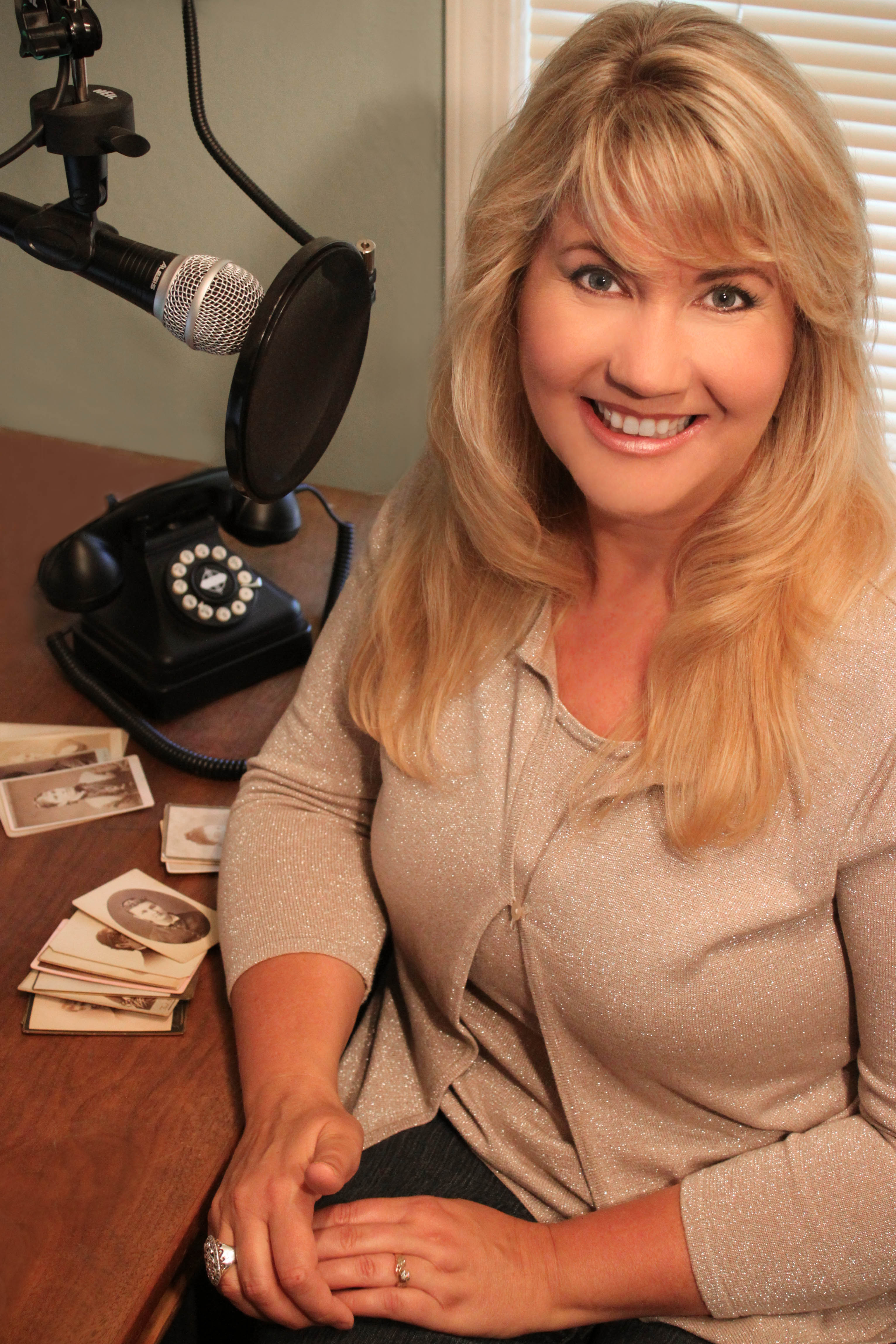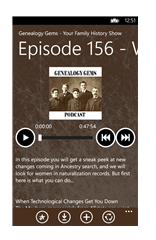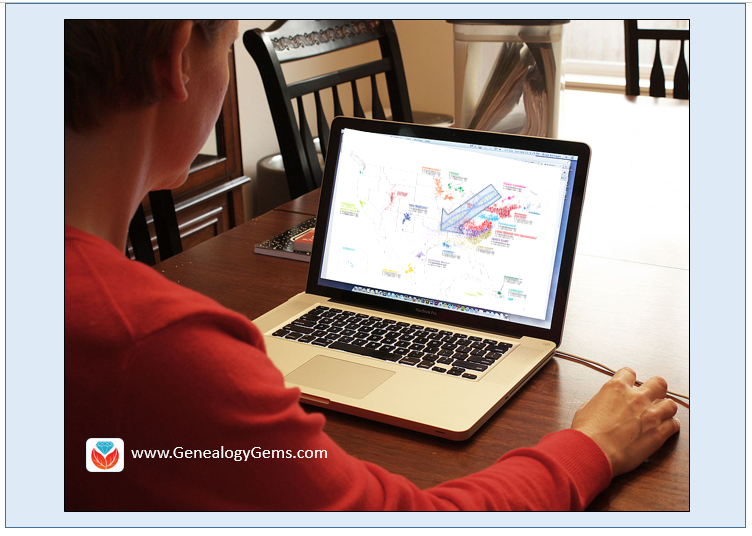by Diahan Southard | Feb 25, 2014 | Certification, Family History Podcast, Research Skills, Source Citation
Originally published 2009. Republished February 25, 2014
https://lisalouisecooke.com/familyhistorypodcast/audio/fh20.mp3
Download the Show Notes for this Episode
Welcome to this step-by-step series for beginning genealogists—and more experienced ones who want to brush up or learn something new. I first ran this series in 2008-2009. So many people have asked about it, I’m bringing it back in weekly segments.

Episode 20: The Genealogical Proof Standard
In this episode we are going to cover a powerful process for doing your genealogy research. It’s called the Genealogical Proof Standard or GPS.
If you’re new to research you may hear some terms that you’re not familiar with. This is the ideal time to start getting familiar with them because it may save you going back and re-doing some of your hard work later down the road.
If you’re an experienced researcher, you may already have had some experience with the GPS. But even if you have, you likely haven’t heard it quite like this. My very special guest is Mark Tucker, a software architect by day and an avid genealogist evenings and weekend. And it’s safe to say Mark has a passion for genealogy and he brings his computing expertise to genealogy in some pretty exciting ways, most recently by process mapping the Genealogical Proof Standard – the GPS – into a visual aid that will help you navigate your way to a successful family tree. (Update: Mark’s Think Genealogy blog is no longer available.)
In our first segment Mark tells us how he got started using the Genealogical Proof Standard, why he created the GPS map, and what it will do for you to improve your genealogy research. Then he gives us an overview of the Genealogical Proof Standard and the various tools that go along with it.
In our second segment we talk about how the GPS map can be effectively used for breaking down your research brick walls.
What is the GPS?
The Genealogical Proof Standard speaks to the quality of our genealogy research process, as outlined in the BCG Genealogical Standards Manual. BCG stands for the Board of Certification of Genealogists, and it’s an internationally recognized organization that certifies qualified genealogists who meet their standards.
The idea behind the GPS is that it provides standards generally accepted in the field of genealogy research. Historically the GPS has been thought of in conjunction with professional genealogists. But more and more it is being used by family historians everywhere who want to do a quality job of climbing their family tree.
The Genealogical Proof Standard is really like a process map. It maps out the proven steps that a good genealogist takes to answer their family tree questions.
Proof is a fundamental concept in genealogy. In order for your research to really be accurate and dependable, each conclusion you reach about an ancestor must have sufficient credibility to be considered as proven. To make sure that conclusions you come to about your family are accurate they really need to meet standards of the Genealogical Proof Standard (The GPS). The GPS consists of five major criteria:
- You have to be sure that you have conducted a reasonably exhaustive search.
- You need to have complete and accurate source citations.
- You need to do the analysis and correlation of the information that you’ve found. It’s not just enough to find a fact, you have to look at it within the context of all of the fact and make sure that it fits together in a way that really makes sense.
- If that analysis brings to light the fact that there are conflicts when you put your data together, then your next step is to go back and work to resolve any conflicting evidence. You’ll want to look for additional resources to solve the question at hand.
- You need to be able to write a sound, reasoned, and coherent conclusion. If you can summarize your findings in a way that makes sense and you can show your proof you know that you’re in good shape and your hard work meets the Genealogical Proof Standard.
The GPS is not just a tool for professional genealogists, but it’s also a tool for you and your research. It actually makes a lot of sense, and it’s pretty simple when you break it down into the 5 basic steps:
- Conduct a reasonably exhaustive search;
- Document complete and accurate source citations;
- Analyze and correlate all of the collected information;
- Resolve any conflicting evidence;
- Write a sound reasoned, and coherent conclusion.
GPS Resources
Mark’s Genealogy Research Process Chart and Powerpoint presentation “Navigating Research with the GPS.” (Unfortunately this is no longer available.)
Learn more about Genealogy Ethics and Standards at the Board for Certification of Genealogists.
The Historical Biographer’s Guide to the Research Process Quicksheet, a laminated quick reference guide by Elizabeth Shown Mills.
by Lisa Cooke | Sep 3, 2015 | 01 What's New, Book Club, Cloud Backup, Digital Archives, Disaster Prevention, Genealogy Gems Podcast, Humor, Organization, Photographs, Preservation
 Digitization tips for old home movies and photos. Online storage and computer backup tips. The Genealogy Gems Book Club interview with Pamela Smith Hill, the editor of the new Laura Ingalls Wilder biography, Pioneer Girl.
Digitization tips for old home movies and photos. Online storage and computer backup tips. The Genealogy Gems Book Club interview with Pamela Smith Hill, the editor of the new Laura Ingalls Wilder biography, Pioneer Girl.
These are all highlights of the free Genealogy Gems Podcast episode 183, newly-published and available for your listening pleasure on our website, through iTunes and the Genealogy Gems app.
 A special feature is an exclusive interview with digitization expert Kristin Harding from Larsen Digital. She is passionate about getting old photos and movies safely digitized and into storage we can access in the years to come!
A special feature is an exclusive interview with digitization expert Kristin Harding from Larsen Digital. She is passionate about getting old photos and movies safely digitized and into storage we can access in the years to come!
As always, you’ll hear from fellow genealogy lovers who have written in with comments and questions. Diahan Southard returns from her summer break with a great new DNA story that settled an old scandal involving U.S. President William G. Harding.
So tune in and enjoy the free Genealogy Gems Podcast Episode 183! Then why not share it with a friend who may like it, too? Thank you!
by Lisa Cooke | Jul 15, 2013 | 01 What's New, Genealogy Gems Podcast, Technology
 The Genealogy Gems Podcast App is now available for Windows 8 phone, tablets and desktop! Our app provides you the ability to stream or download free Genealogy Gems Podcast content, and even share your favorite episodes. Here’s what you need to know:
The Genealogy Gems Podcast App is now available for Windows 8 phone, tablets and desktop! Our app provides you the ability to stream or download free Genealogy Gems Podcast content, and even share your favorite episodes. Here’s what you need to know:
 Phone / Tablet: First, download the Genealogy Gems phone app for $2.99 from the Windows Phone Store.
Phone / Tablet: First, download the Genealogy Gems phone app for $2.99 from the Windows Phone Store.
Once installed, a live tile will be available on the start menu. Opening the app will provide you a list of episodes available for the show.
You can swipe left or right to move through favorites, downloaded episodes, and recently played episodes.
Selected episodes will be highlighted with a check mark in the corner. Tapping on an episode you wish to listen to will open an in app player.
Clicking on the three dots in the lower right hand corner will open up the menu shortcuts, giving easy access to marking episodes as favorites, downloading the episodes for offline listening, or sharing the episodes out with your friends.
Desktop. Download the Genealogy Gems desktop app ($2.99 from the Windows Desktop App Store.)
Opening the app will provide you a list of episodes available for the show on the right with a player on the left and utilizes all the standards of the Windows 8 navigation. Selected episodes will be highlighted with a check mark in the corner.
An episode can be bookmarked by marking it as a ‘favorite’, and episodes can be downloaded so that they are available offline.
When downloading a file, the status of the download will appear. Once an episode is favorited or downloaded, you can set the app to show only those favorite episodes or those downloaded files. You can also view a list of what episodes were recently played.
The Genealogy Gems Podcast app is the one and only family history podcast app available, and was named a Must Have Apps for Hobbies by App Advice.
by Lisa Cooke | Mar 13, 2017 | 01 What's New, DNA
Do you need help solving your family migration patterns? A groundbreaking new scientific study uses DNA and family trees to map migration routes across North America.

Family Migration Patterns Revealed in Genomes
A new study published in Nature Communications represents a ground-breaking development in using DNA for genealogy. The article from the AncestryDNA Scientific Team is titled Clustering of 770,000 genomes reveals post-colonial population structure of North America. Or, in more understandable terms, “Your DNA can tell us where you came from in America in the last 500 years.”
Wow, right? So, how did they do this?
The power really is in the numbers. In this particular paper, they started with using their autosomal DNA test on 770,000 people. Some of them were AncestryDNA customers who had consented to be part of the research. From these 770,000, they learned quite a bit about the migration patterns of early Americans. As Ancestry analyzes more individuals using these same principles of correlating genetics and genealogy, this data will improve and be able to tell us even more about our heritage. Even though it takes a large data set to figure out the relationship between our DNA and migration patterns, it really comes down to the relationship of two people.
To start, Ancestry determines how just two people are genetically related. Then, they find how those two are related to a third person, again, looking only at pairs of people. This goes on and on until everyone in the group as been compared. They use a graph to plot those relationships, with those more closely related clustering around each other. And then it happens. The point where we see the marriage of genetics and genealogy suddenly appear by adding in the family history information for each of these individuals in the cluster.
What they found was astounding. They have displayed the data in Figure 3 shown below. It is a map of the United States with colored dots scattered across the landscape. The location of the dots corresponds to the genealogy of those tested, while the color of the dots relates to their genetic clustering. Those who cluster closest together are the same color. The result is a nearly perfect rainbow, with buy anti anxiety medication online uk each color holding its respective spot on the map, with very little overlap between groups.

Distribution of ancestral birth locations in North America. Summary map from Nature Communications; click to see article with full explanation of map data. Image used with permission of Ancestry.com.
We might be tempted when looking at the map to think, oh, well, of course there is a large population of European Jews in New York, everyone knows that. But this isn’t their family history, their accent, or their culture telling us this – it is their genetics!
As if that wasn’t exciting enough, the scientists describe how we can trace family migration patterns of different groups over just a few generations. They specifically mention French Canadians and Cajuns/Acadians, but the same principle can theoretically be applied to dozens of other groups.
Family Migration Patterns and Applying these Findings
 So what does this mean for you as a genealogist?
So what does this mean for you as a genealogist?
It means we are getting closer than ever to being able to tell who you are and where you came from using your DNA.
For example, let’s say you have an ancestor in Texas about 4 generations ago, but you aren’t sure where she came from. Your DNA could tell you that you fit into the Lower South group, meaning that your ancestor likely hails from the south. Or, maybe your genetics identify with the Upland South, which means you need to explore records from Arkansas, Tennessee, and North Carolina.
This is just a glimpse into the advances that genetics are bringing to your genealogy toolbox these days. So it’s high time to go “all in” to learn about genetic genealogy! We recommend The Family Tree Guide to DNA Testing and Genetic Genealogy by Blaine Bettinger. You’ll love this book if:
- You’ve got brick walls that traditional research methods haven’t been able to break down
- You want to take advantage of the hottest tool in genealogy
- You’ve already taken a DNA test and want to know what comes next
Disclosure: This article contains affiliate links and Genealogy Gems will be compensated if you make a purchase after clicking on these links (at no additional cost to you). Thank you for supporting Genealogy Gems!



 A special feature is an exclusive interview with digitization expert Kristin Harding from Larsen Digital. She is passionate about getting old photos and movies safely digitized and into storage we can access in the years to come!
A special feature is an exclusive interview with digitization expert Kristin Harding from Larsen Digital. She is passionate about getting old photos and movies safely digitized and into storage we can access in the years to come!
 The Genealogy Gems Podcast App is now available for Windows 8 phone, tablets and desktop! Our app provides you the ability to stream or download free Genealogy Gems Podcast content, and even share your favorite episodes. Here’s what you need to know:
The Genealogy Gems Podcast App is now available for Windows 8 phone, tablets and desktop! Our app provides you the ability to stream or download free Genealogy Gems Podcast content, and even share your favorite episodes. Here’s what you need to know:


 So what does this mean for you as a genealogist?
So what does this mean for you as a genealogist?